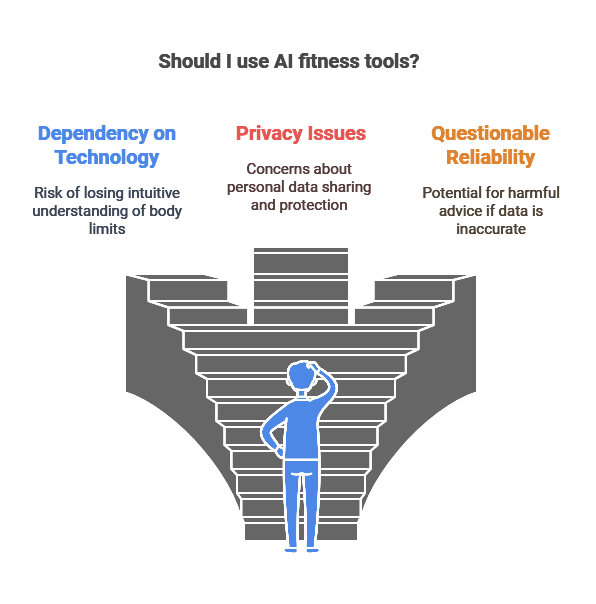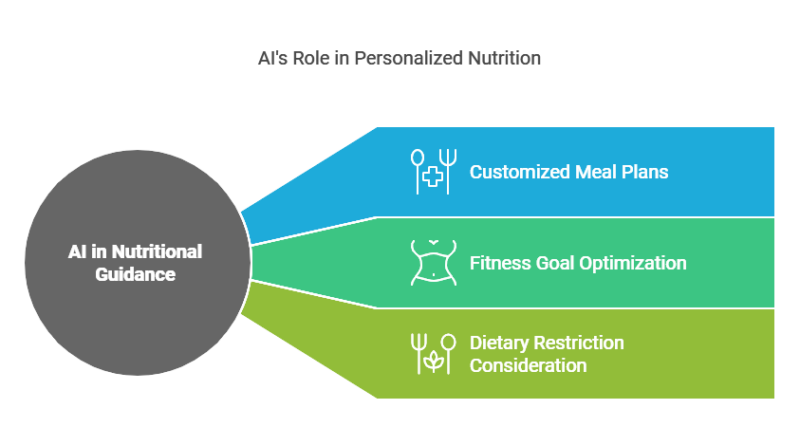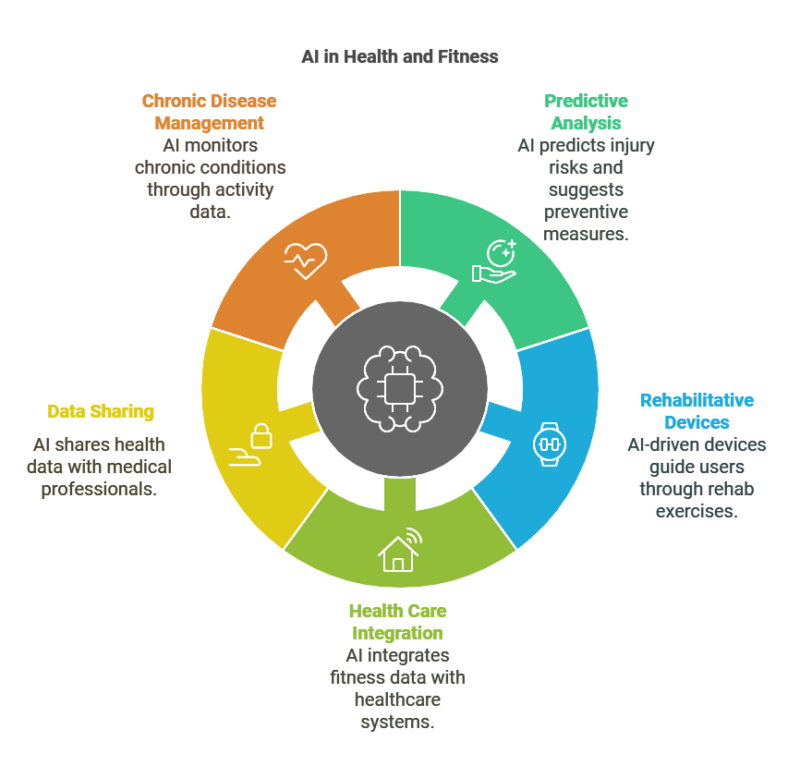Artificial
intelligence
(AI)
is
stepping
into
the
fitness
arena
with
some
promising
tools
designed
to
transform
how
we
exercise.
Let’s
explore
the
upsides
and
downsides
of
using
AI
to
get
fit,
so
you
can
decide
if
it’s
a
help
or
a
hype.
AI
has
the
potential
to
revolutionize
exercise
routines
by
offering
customized
and
scalable
solutions,
but
it’s
important
to
understand
its
limits
and
implications
fully.
What
Is
AI
in
Fitness?
In
the
fitness
world,
AI
refers
to
systems
that
use
data
and
machine
learning
to
offer
personalized
workout
guidance.
Think
of
it
as
having
a
digital
personal
trainer:
it
assesses
your
performance,
tailors
your
workouts,
and
provides
feedback:
all
aimed
at
making
your
fitness
journey
more
effective.
This
technology
utilizes
complex
algorithms
to
analyze
your
physical
data
in
real
time,
adapting
to
changes
in
your
fitness
level
as
you
progress.
The
advent
of
AI,
including
tools
like
the
ChatGPT
detector,
helps
in
ensuring
the
reliability
and
precision
of
fitness
advice
by
filtering
out
misleading
information
and
verifying
the
sources
of
fitness
data.
Benefits
of
AI
in
Fitness
There
are
several
ways
AI
can
add
value
to
your
workouts.
Here
are
a
few
highlights:
-
Personalized
Workout
Plans:
AI
algorithms
can
create
and
adjust
your
fitness
plan
based
on
your
progress,
goals,
and
even
how
you’re
feeling
that
day.
This
dynamic
adjustment
helps
to
optimize
your
workouts,
ensuring
you
always
train
at
the
right
intensity
for
your
current
fitness
state. -
Accessibility:
With
AI,
you
can
bring
your
workout
anywhere.
It
fits
your
schedule,
eliminating
the
need
to
match
up
with
gym
hours
or
trainer
availability.
This
means
you
can
maintain
a
consistent
workout
routine
even
when
traveling
or
during
busy
periods
at
work. -
Instant
Feedback:
Devices
and
apps
can
provide
real-time
insights
into
your
form
and
technique,
significantly
reducing
the
risk
of
injury
and
ensuring
your
workouts
are
as
effective
as
possible.
This
immediate
correction
can
accelerate
your
learning
curve
and
help
you
achieve
better
results
faster. -
Enhanced
Motivation:
AI-powered
apps
often
incorporate
elements
of
games,
competition,
and
social
interaction,
which
can
keep
you
engaged
and
motivated
over
time.
They
also
track
your
progress
and
celebrate
milestones,
which
can
boost
your
morale
and
encourage
you
to
stick
with
your
fitness
plans.
Can
AI
Replace
Human
Trainers?
While
AI
can
mimic
some
aspects
of
a
personal
trainer,
it
doesn’t
replicate
the
personalized
encouragement
and
detailed
attention
that
a
human
can
offer.
The
emotional
support
and
accountability
a
personal
trainer
provides
are
still
beyond
AI’s
reach.
Potential
Drawbacks

lacks
the
ability
to
make
nuanced
judgments
about
your
health
and
wellness
that
can
come
from
years
of
professional
training
and
human
insight.
Despite
the
advantages,
there
are
several
issues
you
should
be
aware
of:
Dependency
on
Technology:
There’s
a
risk
that
relying
too
much
on
AI
could
detach
us
from
intuitively
understanding
our
bodies
and
their
limits.
It’s
crucial
to
maintain
a
balance
and
use
AI
as
a
tool,
not
a
crutch.
Privacy
Issues:
Using
AI
fitness
tools
often
means
sharing
personal
data.
It’s
crucial
to
consider
what
data
you’re
sharing
and
how
it’s
being
used
or
protected.
Without
proper
safeguards,
this
data
could
potentially
be
misused
or
exposed
in
data
breaches.
Questionable
Reliability:
AI’s
advice
is
based
on
the
data
it
receives.
If
the
input
is
off,
the
output
will
be
too,
which
could
lead
to
ineffective
or
even
harmful
advice.
Always
cross-check
AI
recommendations
with
common
sense
and
professional
advice.
Cost:
High-quality
AI
fitness
tools
can
be
expensive,
and
costs
can
accumulate
if
you’re
investing
in
multiple
apps
or
devices.
This
financial
commitment
can
be
a
barrier
for
some,
limiting
access
to
these
potentially
beneficial
tools.
AI
and
Nutritional
Guidance

cycling
through
the
Alps
or
running
the
streets
of
Paris
from
your
living
room.
-
AI
technologies
are
beginning
to
bridge
the
gap
between
daily
activity
levels
and
dietary
needs
by
analyzing
user
data
to
provide
customized
eating
recommendations. -
AI
can
analyze
your
caloric
expenditure
from
workouts
and
suggest
meal
plans
that
optimize
your
nutrition
based
on
your
specific
fitness
goals,
such
as
gaining
muscle
or
losing
fat. -
Alsom
advanced
algorithms
can
tailor
recipes
and
food
suggestions
that
not
only
align
with
your
fitness
objectives
but
also
take
into
account
dietary
restrictions,
allergies,
and
personal
taste
preferences.
Virtual
Reality
(VR)
and
AI
in
Fitness
Virtual
Reality
combined
with
AI
offers
an
immersive
fitness
experience
that
can
simulate
various
environments
and
scenarios
to
make
workouts
more
engaging.
VR
can
transport
you
to
these
locales,
with
AI
adjusting
the
scenario
in
real-time
based
on
your
performance
metrics.
By
turning
a
routine
workout
into
an
interactive
gaming
experience,
VR
and
AI
can
significantly
boost
motivation
and
make
the
exercise
feel
less
like
a
chore.
The
Role
of
AI
in
Injury
Prevention
and
Recovery

AI
fitness
apps
could
share
valuable
health
data
with
medical
professionals
-
Predictive
Analysis:
By
analyzing
your
workout
intensity,
frequency,
and
form,
AI
can
predict
potential
injury
risks
and
propose
preventive
measures
such
as
altered
workout
intensity
or
specific
strengthening
exercises. -
Rehabilitative
Devices
and
Apps:
AI-driven
devices
and
apps
can
guide
users
through
rehabilitation
exercises,
offering
adjustments
and
feedback
based
on
the
user’s
recovery
progress. -
Integration
with
Health
Care:
Looking
forward,
AI
in
fitness
is
set
to
integrate
more
closely
with
healthcare
systems.
This
integration
promises
a
more
holistic
approach
to
personal
health
management: -
Data
Sharing:
With
user
consent,
AI
fitness
apps
could
share
valuable
health
data
with
medical
professionals,
providing
them
with
insights
that
could
inform
patient
care
and
health
recommendations. -
Chronic
Disease
Management:
AI
can
help
in
managing
chronic
conditions
such
as
diabetes
or
heart
disease
by
monitoring
users’
physical
activity
and
vitally
linking
this
data
to
their
medical
records
for
continuous
monitoring
by
healthcare
providers.
How
to
Smartly
Integrate
AI
into
Your
Fitness
Routine
-
Set
Clear
Goals:
Knowing
what
you
want
to
achieve
will
help
you
pick
the
right
AI
tools.
Whether
it’s
building
strength,
improving
flexibility,
or
losing
weight,
there’s
likely
an
AI
solution
that
can
help.
Clear
goals
allow
AI
systems
to
better
tailor
recommendations
and
track
progress
effectively. -
Research
Thoroughly:
Look
into
reviews
and
test
out
AI
tools
before
committing.
Pay
special
attention
to
user
experiences
that
match
your
fitness
level
and
goals.
Don’t
hesitate
to
reach
out
to
current
users
or
experts
to
get
their
insights
on
the
effectiveness
and
reliability
of
specific
AI
applications. -
Prioritize
Privacy:
Always
check
the
privacy
policy
of
any
AI
tool.
Know
what
data
you
are
giving
up
and
how
it
will
be
used.
Opt
for
services
that
offer
strong
data
protection
measures
to
keep
your
personal
information
secure.
Use
AI
as
a
Supplement
Use
AI
to
enhance
your
workouts,
not
replace
them
entirely.
Combine
its
insights
with
your
own
understanding
of
your
body
and
fitness
needs.
Remember,
AI
should
support
your
fitness
journey,
not
dictate
it.
In
Summary
The
potential
for
AI
in
fitness
is
enormous,
spanning
from
practical,
daily
applications
to
broad,
systemic
integrations
with
healthcare.
As
these
technologies
develop,
they
promise
not
only
to
enhance
personal
fitness
but
also
to
revolutionize
the
way
we
approach
health
and
wellness
comprehensively.